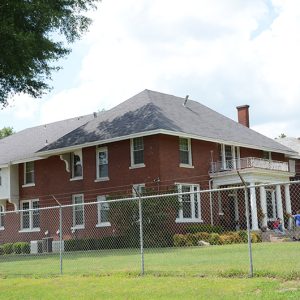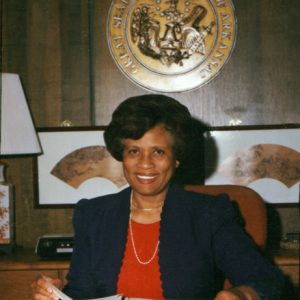calsfoundation@cals.org
Teen Pregnancy
Emerging as a social problem in the United States during the late 1960s and early 1970s, teenage pregnancy has become a complex issue in the United States and around the globe. In the late 1980s and early 1990s, Arkansas’s state health director Dr. Joycelyn Elders, who later became U.S. surgeon general, made combating teenage pregnancy a major part of public health policy in Arkansas. Despite declines in rates since the 1990s, teen pregnancy remains an important public health issue in Arkansas and elsewhere.
From the colonial era through the nineteenth century, the religious and legal concerns associated with teen pregnancy focused less on the parents’ ages and more on whether the parents were wed. Christianity condemned those, especially women, who engaged in premarital or extramarital sex intended for pleasure rather than with the goal of procreation. The desire to protect the so-called legitimacy of children provided the supposed justification for women’s harsher treatment.
Drawn from the English legal tradition that regulated issues of responsibility regarding pregnancies, American bastardy law, including Arkansas’s, shifted the financial responsibility for the child from the state to the parents. Arkansas’s bastardy law of 1875, like its 1838 predecessor, required that putative fathers of out-of-wedlock children pay the mothers’ childbirth-related expenses and monthly child support.
In the nineteenth century and early twentieth century, unwed couples—lacking access to reliable and legal methods of reproductive control—frequently married quickly to handle pregnancies. Arkansas teens could legally consent to marriage. Under state law before 1941, fourteen-year-old females and seventeen-year-old males could marry. Revision to the state law in 1941 raised the age of consent to sixteen for females and eighteen for males, requiring premarital parental consent for girls under eighteen and men under twenty-one.
In the late nineteenth century, evangelical Christians established the Florence Crittenton and Salvation Army rescue homes throughout the country to assist unwed mothers. In 1903, the Little Rock Florence Crittenton Home (LRFCH) began serving clients (but only white clients at this time).
By the 1950s, the options available to unwed women who were pregnant had changed little. Teenagers were part of the clientele of the LRFCH at this time, as well as a separate African-American Florence Crittenton Home, which was located in Sweet Home (Pulaski County).
From the late 1950s through the 1970s, as improved contraception and then legal abortion became available, the American teenage birth rate generally declined. Even so, since 1970, the American teen birth rate has remained higher than that of other developed nations. While many factors influence teens’ sexual and contraceptive behavior, the higher American rate is associated with high poverty rates (occurring particularly in the southern states), inconsistent access to evidence-based sex education, and a lack of universal healthcare coverage. Studies suggest that teenage childbearing is a symptom rather than a cause of poverty, and that some teen girls, who see little chance of economic advancement for themselves, view early motherhood as a form of investment in the future that adds purpose to their lives.
In the 1980s, although the national teenage birth rate had fallen to 51.3 births per 1,000 15–19-year-olds by 1985, many people perceived adolescent pregnancy to be a growing problem. In 1957, the national rate peaked at 96 births per 1,000 females aged 15–19. Between 1986 and 1991, the birth rate rose but never reached the level of 1957, peaking at 61.8 births per 1,000 15–19-year-olds in 1991. In the 1980s, the key difference was that a higher proportion of unmarried teenagers became parents. In addition, teenage mothers frequently faced high-risk pregnancies and limited educational and employment opportunities.
American policymakers on the right and the left held very different views of how to address teen pregnancy. New Right conservatives in the Republican Party, who argued that the availability of sex education, contraception, and legal abortion encouraged adolescent sexual activity, favored abstinence-only policies. Liberal Democrats saw sex education, contraception, and legal abortion as part of the solution, tools that enabled teenagers to make informed decisions about their sexual and reproductive health.
In the late 1980s, the liberal view shaped Dr. Elders’s response to teen pregnancy in Arkansas. A poor state, Arkansas possessed one of the highest overall teen birth rates in the nation and a higher rate for nonwhite teenagers than for whites. In 1988, for example, the state’s birth rate for white teens was 58 births per 1,000 females aged 15–19, while that for nonwhites was 113 births per 1,000 females aged 15–19. Arkansas’s overall birth rate rose from 72 births per 1,000 females aged 15–19 in 1985 to 79.5 births per 1,000 15–19-year-olds in 1991.
Elders supported comprehensive, evidence-based sex education and proposed that public school–based health clinics (SBHCs) be allowed to dispense contraception. Her proposals provoked bitter opposition from conservatives, however, who falsely insisted that the clinics would provide abortion referrals. Elders reaffirmed her support for sex education and reiterated that the health department did not “recommend, support or refer for abortions.”
Passed in 1991, Arkansas’s SBHC statute established very specific rules for clinic operation. Local school boards controlled the clinics, including whether or not contraceptive services would be provided. Clinics could not provide abortion services or use state funds to purchase contraceptives. Receipt of contraceptive services required written parental consent. Sex education programs, if provided, were required to stress premarital abstinence.
In the early 1990s, Little Rock Central High School (Pulaski County), Lincoln High School (Washington County), and Lake View High School (Phillips County) voted to include contraceptive services in their SBHCs. Elders recalled that “the first year [at Lake View]…the pregnancy rate went to zero [and] we learned which interventions worked well and which didn’t and why.”
In 2018, largely as the result of improved contraceptive use, the overall American teen birth rate reached a record low of 17.4 births per 1,000 15–19-year-olds, but racial disparities remained. In 2018, the national teen birth rates for whites, blacks, and Hispanics were 12.1, 26.3, and 26.7 births per 1,000 15–19-year-olds, respectively. Compared to the nation, although Arkansas has experienced a substantial decline in its teen birth rates since 1991, the state’s rates are still high. Arkansas’s overall rate in 2018, the nation’s worst, was 30.4 births per 1,000 females aged 15–19. Nonwhite teens in the state continue to have higher rates than whites. In 2018, while Arkansas’s rate for whites was 25 births per 1,000 15–19-year-olds, the rates for black and Hispanic teens were 43 and 38 births per 1,000 15-19-year-olds, respectively.
Some advocates have responded with proposals to improve the quality of sex education in Arkansas. During the 2019 state legislative session, Democratic Senator Will Bond of Little Rock (Pulaski County) introduced Senate Bill 304. Titled the Arkansas Healthy Lifestyle Education Act (HLEA), it was intended to address teen pregnancy and other youth health issues. Opposed by Republicans, the HLEA would have required school health education curriculum to include evidence-based instruction in contraception and abstinence, and allowed objectors to opt their children out of such instruction. In April 2019, HLEA died in the Senate.
A 2022 report by the Arkansas Advocates for Children and Families highlights the fact that Arkansas teens are having babies at a rate nearly double the national average—the Centers for Disease Control and Prevention (CDC) reports a birth rate of 27.8 per 1,000 compared to a national rate of 15.4 per 1,000. (The only state worse than Arkansas for teen birth rates is Mississippi, by only a slight margin.) The agency named multiple variables that contribute to the state’s high rate, but said the “biggest difference is [teens’] use of contraceptives.” Unlike young people in other states, Arkansas teens become less likely to use effective contraceptives as they get older.
A 2020 Arkansas law compels Arkansas schools to teach abstinence, and what is taught is not required to be medically accurate. Written parental consent must be given for students who want contraceptives from SBHCs, and clinics have to keep records of distribution. Also, Arkansas law prohibits SBHCs or state funds to be utilized for abortion referral or services in public schools. Coupled with these laws is the state’s near total ban on abortion in 2022; the only exception to the law is if the abortion will save the pregnant person’s life. To lower the high teen birth rate, Arkansas Advocates for Children and Families recommended mandatory statewide curriculum for “medically accurate sexual education” and free access to long-acting, reversible contraception. It also recommended that the state expand access to healthcare for Black women and girls, and focus on communities whose birth rates are far above the average.
During the 2023 session of the Arkansas General Assembly, Rep. Ashley Hudson, a Democrat from Little Rock, introduced HB1161, which would require public schools and open-enrollment charter schools to “excuse absences due to conditions related to pregnancy or parenting,” as well as giving student parents various option on completing missed school work and requiring schools to provide reasonable accommodations for such parents. Governor Sarah Huckabee Sanders signed it into law on February 24, 2023.
In the twenty-first century, the ongoing challenge is to design and implement policies that allow American teens, no matter what state they live in, to address their sexual and reproductive health needs more effectively.
For additional information:
Boonstra, Heather D. “Teen Pregnancy: Trends and Lessons Learned.” Guttmacher Report on Public Policy 5 (February 2002): 7–10. Online at https://www.guttmacher.org/gpr/2002/02/trends-pregnancy-trends-and-lessons-learned (accessed April 6, 2021).
———. “What Is Behind the Declines in Teen Pregnancy Rates?” Guttmacher Policy Review 17 (Summer 2014): 15–21. Online at https://www.guttmacher.org/gpr/2014/09/what-behind-declines-teen-pregnancy-rates (accessed April 6, 2021).
Earley, Neal. “House OKs Bill to Aid Pregnant Students in State.” Arkansas Democrat-Gazette, February 8, 2023, pp. 1b, 8B. Online at https://www.arkansasonline.com/news/2023/feb/08/state-house-committee-advances-bill-that-would/ (accessed February 8, 2023).
Edin, Kathryn, and Maria Kefalas. Promises I Can Keep: Why Poor Women Put Motherhood Before Marriage. Berkeley: University of California Press, 2005.
Elders, M. Joycelyn, and David Chanoff. From Sharecropper’s Daughter to Surgeon General of the United States of America. New York: William Morrow and Company, 1996.
Fuqua, David. “Bastardy Law in Arkansas: The Need for Revision.” Arkansas Law Review 33 (Spring 1979): 178–193.
Hennigan, Mary. “Study Finds Arkansas Teen Birth Rate Is Second Worst in the Country, Nearly Double National Rate.” Arkansas Times, October 11, 2022. https://arktimes.com/arkansas-blog/2022/10/11/study-finds-arkansas-teen-birth-rate-is-second-worst-in-the-country-nearly-double-national-rate (accessed October 24, 2022).
Henshaw, Stanley K., and Jennifer Van Vort. “Teenage Abortion, Birth and Pregnancy Statistics: An Update.” Family Planning Perspectives 21 (March–April 1989): 85–88.
Henshaw, Stanley K. “Teenage Abortion, Birth and Pregnancy Statistics by State, 1988.” Family Planning Perspectives 25 (May–June 1993): 122–126.
Kearney, Melissa S., and Phillip B. Levine. “Why Is the Teen Birth Rate in the United States So High and Why Does It Matter?” Journal of Economic Perspectives 26 (Spring 2012): 141–166.
Lawson, Annette, and Deborah L. Rhode, eds. The Politics of Pregnancy: Adolescent Sexuality and Public Policy. New Haven: Yale University Press, 1993.
Luker, Kristen. Dubious Conceptions: The Politics of Teenage Pregnancy. Cambridge, MA: Harvard University Press, 1996.
Martin, Joyce A., Brady E. Hamilton, and Michelle J. K. Osterman. “Births in the United States, 2018.” National Center for Health Statistics Data Brief No. 346 (July 2019): 1–7. Online at https://www.cdc.gov/nchs/products/databriefs/db346.htm (accessed April 6, 2021).
Petchesky, Rosalind Pollack. Abortion and Woman’s Choice: The State, Sexuality, and Reproductive Freedom. Rev. ed. Boston: Northeastern University Press, 1990.
Phillips, Rhonda, and Bobbie Ridlehoover. “Perspectives: School-Based Health Clinics.” Arkansas Democrat, September 25, 1988, p. 137.
Power to Decide. “Arkansas Data.” http://powertodecide.org/what-we-do/information/national-state-data/arkansas (accessed April 6, 2021).
Sexual Information and Education Council of the United States. “Arkansas State Profile.” http://siecus.org/state_profile/arkansas-state-profile/ (accessed April 6, 2021).
Singh, Susheela, and Jacqueline Darroch. “Adolescent Pregnancy and Childbearing: Levels and Trends in Developed Countries.” Family Planning Perspectives 32 (January–February 2000): 14–23.
Solinger, Rickie. Wake Up Little Susie: Single Pregnancy and Race Before Roe v. Wade. New York: Routledge, 1994.
“U. S. and State Trends on Teen Births, 1990–2018.” Centers for Disease Control and Prevention. https://www.cdc.gov/nchs/data-visualization/teen-births/ (accessed April 6, 2021).
Ventura, Stephanie J., Brady E. Hamilton, and T. J. Mathews. “National and State Patterns of Teen Births in the United States, 1940–2013.” National Vital Statistics Reports 63 (August 20, 2014): 1–34. Online at https://www.cdc.gov/nchs/data/nvsr/nvsr63/nvsr63_04.pdf (accessed April 6, 2021).
Welch, Melanie K. “Politics and Poverty: Women’s Reproductive Rights in Arkansas, 1942–1980.” PhD diss., Auburn University, 2009.
Melanie K. Welch
Mayflower, Arkansas
 Health and Medicine
Health and Medicine Florence Crittenton Home
Florence Crittenton Home  Joycelyn Elders
Joycelyn Elders 




Comments
No comments on this entry yet.